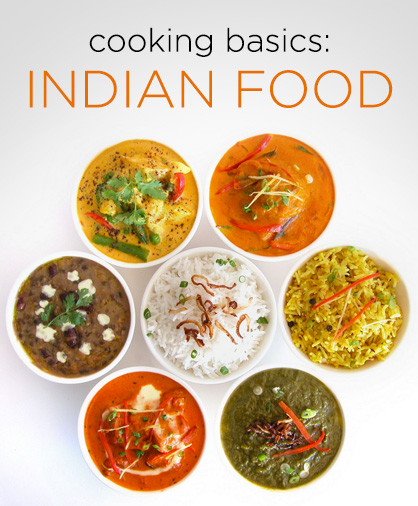Inside an Indian Kitchen: 6 Common Ingredients and Recipes
This week, we tackle Indian cooking. Indian cooking is known for incorporating a vast slew of spices and lengthy ingredient lists, which can be intimidating. Here we present six commonly used ingredients, from India’s most popularly used cheese to a great go-to blend of spices, along with some tasty recipes to get you started with the spicy cuisine. From homemade cheese simmered with spinach to a spicy vegetable medley with Indian rice and a sweet potato and lentil stew, these flavorful Indian dishes will have you wanting to head for the nearest kitchen.
Garam Masala
The ultimate Indian spice mix, garam masala comes from the Indian words for “hot” and “spice.” Use it in small quantities as a base mix to quickly build curries and other Indian staples. While its contents may vary, this subtle spice blend usually gets its flavor from cardamom, cinnamon, cloves, cumin, nutmeg and/or black pepper. It easily overpowers a dish, so use in moderation. Although best made fresh, you can store the blend in an air-tight container for several months or buy a store variety if you are short on patience or time.
Get started with garam masala with the Mixed Vegetable Masala, a hearty Indian stew blending coconut milk and potato, carrot and cauliflower, or the Chole Palak, a protein-rich dish of chick peas simmered in a spicy spinach gravy.
Paneer
With the consistency of tofu, paneer is a soft, fresh Indian curd cheese with a simple flavor. In India they refer to it as “cottage cheese,” although it has no Western counterpart. It is the most commonly used cheese in Indian cooking. One of the easiest cheeses to make at home, you can make your own by curdling milk, tying the whey in cheesecloth and then applying pressure to solidify the curds. Not too high in calories, this versatile, nonmelting cow’s milk cheese is a great go-to protein source for vegetarians. Vegans can make dishes calling for this delicate cheese by substituting tofu.
To get you started with this soft cheese, try Mattar Paneer, which features the cheese with green peas, onion and tomato, or Saag Paneer, which combines it with spinach. Both dishes are Indian restaurant favorites.

Basmati Rice
If you have never experimented with another kind of rice, now is the time. Derived from the word “fragrance,” this aromatic, very long-grain rice has a nonsticky, fluffy texture and a nutty flavor. The ideal rice to use in any Indian recipe calling for rice, the delicate staple is the most well-known variety of Indian rice and is easily found at a local supermarket. Try soaking it in cold water for a few minutes before cooking. A number of basic Indian spices turn basmati rice into an appealing side dish with this Indian Style Rice. Made with an assortment of fresh vegetables, the rich, classic Vegetable Biryani is an Indian staple rice dish.
Ghee
Lacking water or solid milk particles, this Indian clarified butter is made by simmering unsalted butter to evaporate the moisture until the milk solids separate and the butter becomes clear. Used extensively in India, it is preferred to traditional butter because it has a high smoking point (meaning it does not burn while cooking) and is lactose free because the solid milk proteins are skimmed off. With its rich flavor, it adds taste and aroma to almost any dish. As small amounts are so flavorful, it is a good oil choice for those on a low fat diet. Although found in large grocery stores and online, you can make your own at home.
Ghee can be substituted for butter or oil in any Indian recipe. But to get you started, we recommend a simple yet popular Potato Curry or a Kale and Spinach Saag, a healthy modification of an Indian classic that can be a base for chicken or lamb.

Red Lentils
Known as masoor daal in Indian, these salmon-colored lentils are the Indian lentils most widely used in Western countries, as well as the most commonly used daal in India. Masoor daal uses the spilt lentil without the skin. With short cooking time, the earthy legumes can be ready quickly even without soaking, making them a convenient choice. A great protein option, red lentils have the third highest amount of protein by weight of any vegan food after soybeans and hemp. When cooked, they turn golden-colored and mushy, making them perfect for soups and stews, especially the classic Indian recipe dhal.
For a fast and simple recipe with red lentils as its heart, this basic Masoor Daal makes a hearty dish. For a more modern twist on the classic, try this Sweet Potato Dal with spinach and some quiet spice.
Cardamom
A popular Indian spice, cardamom is available in black and green varieties, which come from different plants. With its bold, sweet taste, cardamom can be used to flavor both sweet dishes and savory recipes. The neutrally flavored – and thus useless – pods contain the small valuable flavorful seeds, which can be split, powdered or used whole. More commonly used, green cardamom is smaller, softer and more delicately flavored than black cardamom, which is used in garam masala. While a more expensive spice, cardamom pods can keep indefinitely, while the ground version loses flavor after about a year.
To get started with this spice, add a split pod to simmering rice for an Indian kick. For an easy one-dish meal, this simple Indian Dahl has a fun mixture of vegetables and spices, including turmeric, cumin, cinnamon and – of course – cardamom.
Tagged in: food, recipes, kitchen, cooking, cooking basics, spices, indian,

LadyLUX via Oscars Catering



